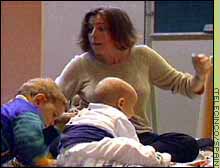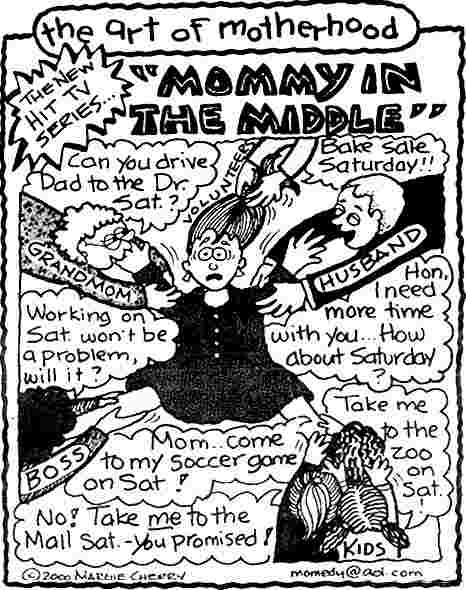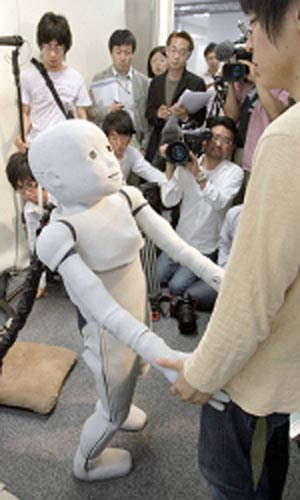Recipe for Disaster
Second Child Too Much for Working MumsI think we're seeing in working mothers a change from "Thank God it's Friday" to "Thank God it's Monday." If any working mother has not experienced that feeling, her children are not adolescent. - Ann Diehl
Aucklander Christine Keys went back to work when her first child was 7 months old. But after her second child, she chose to stay home. "I just felt I could do it with one, but two is double the load and I didn't want to continue in the rat race." The Glendowie mother is one of many who leave their jobs as a result of "second child syndrome." According to British research, women struggle to cope with work and 2 children, and instead choose to leave the workforce. A Kent University study of 400 women shows 75% of mothers return to work after their first baby, but 1/2 drop out of the workforce completely after the arrival of the second child. Auckland University sociology head Maureen Baker said parents often quit work after their second child because of difficulties with childcare. Childcare costs here and in Britain were extremely high compared with other countries. Another factor was the logistics of getting children to and from childcare. Amanda McIntosh, who operates 3 home-based childcare services in Auckland, said that of the 200 children in her care, fewer than 1 in 10 had a brother or sister also in care. She said it was a time factor for parents. "It is not until you get a second child that you realise how much time it takes. It's the sheer logistics [and] you need a lot of resources." The fees were about $6.50 an hour for 2 children. "If you're earning $10 an hour, you have to ask: Is it worth it?" Television news presenter Alison Mau said she would probably work part-time after the arrival of her second child. "[A second child] is just harder," she said. "For many people it must be a nightmare." Rebecca Abrams, whose new book, Three Shoes, One Sock And No Hair Brush: Everything You Need To Know about Having Your Second Child, identifies this situation as second-child syndrome. "Most women are totally unprepared for the impact of a second child on their working lives," she says. "It isn't just the cost of childcare, although that's important. It's the lack of time, the strain on relationships of having both parents in work, the complex logistics of working life with two children. All these factors together prompt - and sometimes force - women to re-evaluate their priorities." - NZPA Source: The Evening Post Monday 26 March 2001
If being able to stay home and do a better job of raising one's children is merely a matter of "re-evaluating priorities" perhaps it's no bad thing...
Source: Funny Times January 2002
This Be the Verseby Philip Larkin (1922 - 1980) They fuck you up, your Mum and Dad. But they were fucked up in their turn Man hands on misery to man
Less Help at Home: Female Support for New Moms on the Declineby Frances K Goldscheider and Berna M Torr How is motherhood different than it was a century ago? In the past, live-in grandmothers, relatives, and other women were frequently available to assist with childcare. But times have changed. New research shows that today’s mothers with young children are getting substantially less help around the house. Even when other women are living in the household, they aren’t necessarily on hand to help with the kids. This research appears in Demography.
Source: www.brown.edu 11 December 2006
19 Minutes - How Long Working Parents Give Their Childrenby Becky Barrow A typical working parent spends just 19 minutes a day looking after their children, official figures revealed yesterday. The startling research shows the devastating impact that working full-time has on children who hardly see their parents. With less than 20 minutes spent with their parents every day, this is only enough time to eat a quick breakfast together or have a couple of bed-time stories. The Office for National Statistics looked at nearly 4,950 people over the age of 16 in Britain to find out what they do all day. The findings make grim reading for working parents who already worry that they spend too much time at work - and too little at home. Parents who work full-time spend just 19 minutes every day "caring for [their] own children", according to ONS's "Time Use Survey", published yesterday. A further 16 minutes is spent looking after their children as a "secondary activity", but this means that they are doing something else - such as the weekly supermarket shop - at the same time. The findings come at a time when record numbers of women are working as huge mortgages and soaring household bills force them to earn a living. Official figures show that 12.6million women have a job, compared to just 8.5million in the 1970s. The ONS looked specifically at working women in Britain and what they do during a typical 24-hour period to create a typical "Diary of a Working Mum". They sleep less and work more than any other "type" of woman - and still have to do about 2½ hours "domestic work" every day, it reveals. A typical working woman gets nearly 40 minutes less sleep every night than a full-time mother who gets more than 9 hours sleep every night. This is because she gets up earlier to travel into work every day, or spends time every night doing a long list of domestic chores before going to bed. On average, a working woman toils at work for over 5 hours a day, although this figure appears low because it includes holidays and weekends when no work is done. Recent research showed that most mothers with young families would prefer to stay at home and look after their children. A survey of working mothers found that just 6% wanted to work full-time, according to Prima magazine. Half wanted to combine bringing up their children with a part-time job, while more than a quarter wanted to be a full-time mother. They were asked: "In an ideal world, what would you like to be?" 26% said they wanted to be a "housewife and mother". The most popular response, given by 50%, was to be a "mum who works part-time". Maire Fahey, editor of Prima, said: "In the 1980s, we thought we could have it all and aspired to high-flying careers and happy families. But the cracks are starting to show. Family life is suffering and something has got to give." The new ONS survey shows that life is also extremely tough for fathers with young families, particularly those whose youngest children is under the age of 4. They sleep less, works more and do more "domestic" work than any other "type" of man, such as one with older children or one with no children. A typical father whose youngest child is under 4 gets less than 8 hours sleep a night and does more than 3 hours of domestic chores every day. They are also working more than one hour a day longer than their male colleagues who do not have children. Overall, the ONS found that a typical person's 24-hours is mostly spent sleeping, working and watching television, which are the top three activities. A woman will spend 8.3 hours asleep, 2.4 hours watching television, DVDs or videos and 2.2 hours working. A man will spend 8 hours alseep, 2.8 hours watching television, DVDs or videos and 3.5 hours working. Just 24 minutes in 24 hours is spent reading, a figure which drops to just 10 minutes for younger people. Source: dailymail.co.uk 19 July 2006
In a choice between watching TV or spending time with the kid(s), it is clear which is more important. But there is now an alternative! Child Robot Makes Debut
A child-sized android stands up with assistance. A child-sized android with flexible joints and soft skin developed by the Japan Science and Technology Agency was unveiled Friday at Osaka University, where the agency's research and development team is based. The 1.3-meter-tall, 33 kilogram humanoid robot has optical, auditory and tactile sensors. 51 actuators inside its body run on compressed air and enable the robot to make complex movements smoothly. About 200 tactile sensors are embedded in the robot's gray skin, which is made of silicon and other materials. The robot can react to its surroundings by blinking and altering its facial expressions. The robot, which has the physical ability of a 1- or 2-year-old toddler, can turn over and stand up with assistance. At the news conference Friday, the humanoid moved its hands and feet and turned its eyes. Its name is CB2, an abbreviation of Child-Robot with Biomimetic Body. Source: yomiuri.co.jp The Yomiuri Shimbun 2 June 2007
Artifact ChildrenTerm invented (or at least popularized) by the late musician Frank Zappa to describe children conceived primarily for the experience of having them.
Source: urbandictionary.com
What Is Walter Miller Jr’s Short Story "Conditionally Human" about?This story imagines a future world where over-population has created a need for drastic social measures. The only people allowed to breed are "Class A" - those with an impeccable health and genetic record. To comfort them in their childless state, the rest of the population are allowed to have specially engineered pets which look more or less human and can utter simple words. Their intelligence is kept at the level of a small child, and their lives are short; if they don’t die, they are rounded up and quietly disposed of. A man whose job is to arrange this disposal finds himself in a dilemma. He finds one of these "pets" being concealed by her adoptive grandfather, who has taught her to pretend to be like the other mutant children. In fact, she ... has intelligence as great or greater than that of a human child. To kill her would clearly be murder... Source: blurtit.com 6 December 2006 See also:
For articles related to lifestyles including guns, television, extortion, hair, handbags, parenting, time bind, desserts, fitness, feasting, friends, happiness, ageing and more,
click the "Up" button below to take you to the Index for this Lifestyles section. |
 Animals
Animals Animation
Animation Art of Playing Cards
Art of Playing Cards Drugs
Drugs Education
Education Environment
Environment Flying
Flying History
History Humour
Humour Immigration
Immigration Info/Tech
Info/Tech Intellectual/Entertaining
Intellectual/Entertaining Lifestyles
Lifestyles Men
Men Money/Politics/Law
Money/Politics/Law New Jersey
New Jersey Odds and Oddities
Odds and Oddities Older & Under
Older & Under Photography
Photography Prisons
Prisons Relationships
Relationships Science
Science Social/Cultural
Social/Cultural Terrorism
Terrorism Wellington
Wellington Working
Working Zero Return Investment
Zero Return Investment


